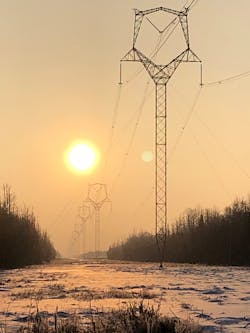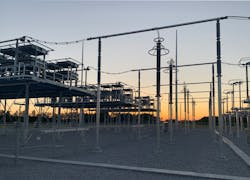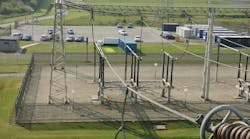The energy industry has a pivotal role to play in the U.S.’s plans for combating climate change. According to the International Energy Agency (IEA), power generation accounted for more than 40% of global greenhouse gas (GHG) emissions in 2019. Driving this number down will require commitment across the energy ecosystem.
To achieve the U.S.’s goal of reducing its greenhouse gas emissions by 65% by 2030 and reaching full carbon neutrality by 2050, the energy industry, broadly speaking, needs to shift away from fossil fuels toward more carbon-free energy sources such as wind, solar and hydroelectric power. Building a reliable supply of sustainably sourced electricity will require robust and efficient transmission networks to link sustainable energy sources more effectively with the load centers where needed in a cost-effective way.
Minnesota Power is doing its part, setting — and achieving — goals that are even more ambitious than the federal government’s targets. In 2021, Minnesota Power became the first utility in its home state to deliver 50% renewable energy to its customers, and the utility is on pace to achieve 100% carbon-free energy by 2050. One way it has been able to meet these milestones is with power quality solutions that optimize the flow of power over both new and existing transmission lines, providing substantial increases in the amount of power delivered.
Great Northern Line
Minnesota Power’s EnergyForward strategy was implemented to support the transition to cleaner energy sources while meeting rising customer expectations for a safe, reliable, stable and affordable electricity supply across a smarter and more resilient grid. To achieve these goals, the utility completed construction of a new extra-high-voltage tie line between southern Manitoba, Canada, and northeastern Minnesota, in 2020. The goal of the Great Northern transmission line project was to enhance transfer capability and reliability of the transmission connection between Manitoba and Minnesota, increasing access to clean, sustainable energy for Minnesota Power’s customers in northeastern Minnesota and the broader Midwest.
The Great Northern transmission line helped to diversify the mix of clean and reliable energy sources, strengthened overall system reliability throughout the region and enabled innovative energy storage provisions by leveraging synergies between abundant hydroelectric resources located along the Nelson River system in northern Manitoba and Minnesota Power’s wind
resources in central North Dakota.
Development of the new 500-kV tie line, which is more than 350 miles (563 km) long between its Manitoba and Minnesota end points, took nearly a decade from the earliest project development stages to construction and commissioning. Major components of the Great Northern transmission line project included a new single-circuit 500-kV line on steel lattice towers, a new 500-kV series compensation station located near the midpoint of the line and a new 500/230-kV substation interconnected to Minnesota Power’s existing 230-kV system near Grand Rapids, Minnesota. Within the new 500/230-kV substation, the project also included two 150-MVAR, 500-kV line-end shunt reactors, a 150-MVAR, 500-kV shunt capacitor, and a 1200-MVA, 500/230-kV autotransformer bank consisting of three single-phase units and one installed spare.
A key element of this effort was the installation of one of the world’s largest series capacitor banks, deployed in Warroad, Minnesota. Supplied by Hitachi Energy Ltd., this 500-kV, 1440-MVAR series capacitor bank enhanced the transfer capability of the new 500-kV line, optimizing the overall capacity and efficiency of the transmission interface between Manitoba and Minnesota and substantially increasing Minnesota Power and other regional utilities’ access to clean hydropower from Canada. The result of the series-compensated Great Northern transmission line project was an increase in the total Manitoba-U.S transfer capability of more than 880 MW.
Located in the middle of the line, the series capacitor bank consists of two segments of equal size installed on a common platform about 20 ft (6 m) above the ground. The Warroad series compensation station included one platform per phase, with each of the three identical platforms supporting the capacitor banks and protective bypass circuitry for both segments of a single phase of the transmission line. This platform installation enabled operation of the series capacitors at line voltage while connected in series with the transmission line. Two segments, instead of one, were installed at the Warroad station because of the total amount of series compensation required — a function of the transmission line length. At 1440 MVAR, this installation was the largest megavoltampere reactive (MVAR) value in a single platform Hitachi Energy had ever built.
Power quality solutions, like series capacitors, can help to minimize energy losses over longer transmission lines, optimize transmission system transfer capacity, support stable and predictable system operations, and provide added flexibility to meet shifts in demand during unplanned network events. These benefits were achieved by reducing the series impedance of the transmission line, a key electrical parameter, directly related to the length of the line, which has a strong influence over the performance of the power system.
Integrating Energy Sources
Integrating clean energy resources into the grid presents a variety of challenges. Often, renewable generation sources are located far from areas where traditional fossil-fuel power plants historically have been based. This distance can lead to more variation in regional power flow patterns. It also can cause stability and reliability issues as the industry transitions away from its historical use of fossil-fuel power plants toward renewable energy resources, which makes reliable long-distance transmission infrastructure even more critical. In the case of Minnesota Power, the utility was simultaneously incorporating hydroelectric power from Canada and wind power from North Dakota into its energy mix. This required sufficient transmission system capacity and flexibility to ensure optimal use of power and delivery to Minnesota Power’s customers when needed.
The new series capacitor bank in Warroad also enabled the efficient routing of power onto the new 500-kV transmission line from four existing tie lines between Manitoba and the U.S., allowing Minnesota Power, Manitoba Hydro and the Midcontinent Independent System Operator (MISO) to make better use of the existing transmission system after integration of the new 500-kV line. It also was particularly important to achieve a high degree of coordination between the complex control, protection and communication systems associated with the new 500-kV line and Manitoba-U.S. interconnection.
The long distance of the transmission line and amount of series compensation and other reactive resources required to support it created unique technical challenges for control and protection system design as well as system integration. CapThor, a bypass device developed by Hitachi Energy, and an upgraded control system, MACH, were implemented to overcome these technical challenges, so the line performance would meet Minnesota Power’s expectations.
The Drive To Diversify
As Minnesota Power integrates more and more variable renewable energy sources, like wind generation, into its power mix locally, the interface with Manitoba can be used to store excess renewable generation by leveraging the dispatchability of Manitoba’s hydroelectric resources at times of day when variable renewable energy resources are most productive, specifically when the wind is blowing.
Subsequently, when the variable renewable resource output is low, Manitoba’s hydroelectric resources can produce more power, sending back the renewable energy stored behind a dam, serving as a kind of battery for its neighbors to the south. In this way, Minnesota and Manitoba together can take advantage of the renewable generation capacities in their respective regions to create a more sustainable system overall.
Sustainable Energy Transition
Minnesota Power’s energy mix has changed substantially in recent years and will continue to evolve as the utility moves to decarbonize its electricity supply and provide greener power to businesses and consumers. It is imperative all available sources of clean energy are used to their fullest extent, to ensure Minnesota Power can meet its carbon reduction goals and continue to contribute to both regional and national efforts to transition toward a carbon-free energy supply.
Its strategy involves continually expanding access to wind and solar power using large-scale hydropower in Manitoba, created by the Great Northern transmission line project, and leveraging the flexibility of natural gas to ensure reliable and consistent power 24/7 for customers. The increased use of hydropower from Manitoba plays an important part in this strategy and makes good sense both economically and environmentally. Increasing the capacity and efficiency of new and existing transmission infrastructure is critical to this effort.
Power quality solutions such as the series capacitor bank deployed for this project have helped Minnesota Power to get the most out of its transmission infrastructure and ensure power generation in the region is used more efficiently.
Christian Winter ([email protected]) is supervising engineer of T&D planning for Minnesota Power. He started his career in transmission planning with Minnesota Power in February 2009 and is presently responsible for providing technical leadership and oversight of a group of engineers focused on the long-term planning of Minnesota Power’s T&D systems. As the electrical studies lead on the Great Northern transmission line project from 2012 through project completion, Winter had the opportunity to participate in many stages of the project life cycle, including initial project scoping, siting and permitting, detailed design, engineering, construction and commissioning. Winter has a bachelor’s degree in electrical engineering from North Dakota State University in Fargo, North Dakota, and is a licensed professional engineer in Minnesota.
Cesar Reyes ([email protected]) is senior project manager for grid power quality systems at Hitachi Energy. In this role, Reyes is responsible for leading and managing projects in electrical infrastructure, including flexible alternating-current transmission systems (FACTS) and substations, for the North American market. Reyes has more than 16 years of experience in engineering and project management for the utility sector, working with construction contractors, public utilities, turnkey solution providers and original equipment manufacturers. Reyes holds an Executive MBA degree from Temple University in Philadelphia, Pennsylvania, U.S., and a BSME degree from Universidad Nacional de Colombia in Bogota, Colombia.






